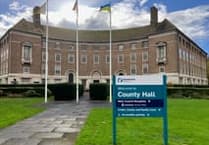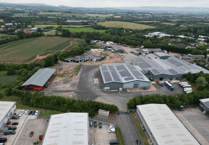TENS of thousands of new trees will be planted on Exmoor in the winter of 2024 to replace those being felled in a controversial clearance operation near Wootton Courtenay.
But parish councillors in Timberscombe were also told further thinning of the woods on Wootton Ridge, near the Oway, would happen in another five or six years’ time.
Timberscombe Parish Council took up concerns with Forestry England and has now heard back from its Exmoor and Quantocks area forester John Ebsary.
Mr Ebsary said the tree felling on Wootton Common was the first for more than 20 years and was designed to improve the long-term health and resilience of the forest.
He said the woodlands had been difficult to access until a new service road was installed in 2021, which meant the forest’s trees were mostly of a similar age and size.
Mr Ebsary said: “This creates a uniform forest structure that limits both the habitat value and aesthetic character of the forest.
“We are currently thinning trees across a wide area to break up this structure.
“This has multiple benefits, giving the remaining trees more light and warmth to grow to their potential, improving conditions for flora on the forest floor, enhancing habitat for wildlife, increasing the resilience of the forest against pests and diseases.
“We are also clear felling two smaller areas to remove mature trees and those at risk of storm damage.
“In these areas, the ground will rest for a year or two before we plant more than 30,000 new trees.
“These will be a mixture of conifer species that are suitable for the conditions on site.
“In the meantime, the resting ground will soon ‘green up’ and provide wonderful habitat for ground nesting birds such as nightjar, small mammals, insects, and reptiles.”
Mr Ebsary said planning the most suitable time of year for forestry work required a ‘complex compromise’ between the needs of people and wildlife, the safety of the site, tree health, local topography such as steep slopes which might cause water run-off, soil condition, likely rainfall, and much more.
He said: “There is no perfect time of year for forestry work, we make local decisions based on detailed assessments of the site, including thorough ecology surveys.
“It is a common misconception that nature ‘is best left to its own devices’.
“In fact, harvesting trees is not only an important part of sustainable forest management, but well managed forests support more wildlife.
“In Wootton Common, we have several interesting species, including raven, and badger, and plenty of favourable bird breeding habitat.
“As well as placing ‘exclusion zones’ around known nests and setts to minimise disturbance, we adapt our work in response to wildlife activity on site.
“For example, our current work was due to start at Ranscombe Combe, but, due to finding active nests of protected birds and a badger sett, work was started far away in Knowle instead.”
Mr Ebsary said Forestry England worked hard to balance the need for woodland management and sustainable timber with the year-round activity of wildlife.
He said the challenges were explained in more detail on its website www.forestryengland.uk/article/felling-and-nesting-birds.
“Bringing the woodlands across Wootton Common back into regular management will have long-lasting benefits for the health of both the forest and its wildlife,” said Mr Ebsary.
Dunster Park and Heathlands site of special scientific interest (SSSI) ran along the northern edge of the woodland, which was in part notified for its population of heath fritillary, a conservation priority species.
Mr Ebsary said although not required by Natural England, the forestry agency was taking the opportunity to improve its areas of favourable habitat and open space to connect them with the SSSI to benefit the valuable butterfly species.
He said: “Depending on weather conditions and wildlife activity, we hope to finish the current forestry operation by early autumn.”
Mr Ebsary said local residents could help the work to be finished as quickly as possible by following all closure and diversion signs, because significant work time could be lost if the public entered a work site.
He said: "Forestry work is very hazardous. A falling tree can weigh several tonnes and hit the ground at nearly 60 mph.
“If a harvesting machine chainsaw snaps, it can fly through the forest like a bullet.”
Mr Ebsary said the full forest plan for Exmoor National Park was available online at www.forestryengland.uk/forest-planning/exmoor-forest-plan or by searching ‘Exmoor Forest plan’.
Any questions about the Wootton Ridge work or felling elsewhere on Exmoor could be raised by emailing [email protected].
Timberscombe parish clerk Lesley Webb said: “We are still working with Forestry England and Exmoor National Park on how they can better inform local landowners and the public of impending works.”



